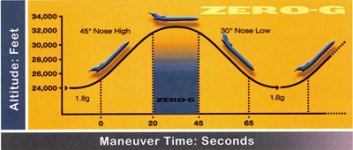What was a great surprise to me was to be informed recently by a world class satellite expert the following.
The so called parabolic flights to simulate weightless conditions, in I think strengthened Boeing 727s, cannot be parabolas. They must be ellipses.
Furthermore, and negating my teaching on projectiles is that shells, bullets etc, travel in ellipses not parabolas. These are of course modified by air resistance.
Satellites do not travel in parabolas if you want to stay in orbit, they travel in ellipses, as do all these other projectiles under the influence of gravity.
The so called parabolic flights to simulate weightless conditions, in I think strengthened Boeing 727s, cannot be parabolas. They must be ellipses.
Furthermore, and negating my teaching on projectiles is that shells, bullets etc, travel in ellipses not parabolas. These are of course modified by air resistance.
Satellites do not travel in parabolas if you want to stay in orbit, they travel in ellipses, as do all these other projectiles under the influence of gravity.






